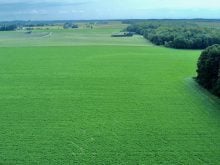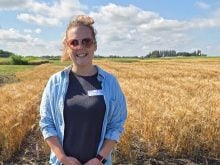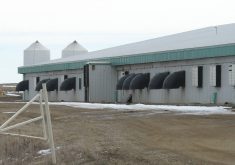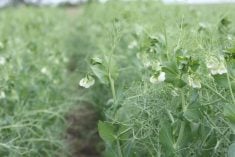A soil health advocate says we must break the cycle that sees productivity drop as food demand increases
Soil aggregates are the key to the future of soil health, but they are not well cultivated on much of the land, placing soil health, and thus the future of agri-food, in jeopardy, says Don Lobb, a longtime advocate of soil health.
“For the first time in history we have the capacity to produce food in a sustainable way,” said Lobb at the Farm Forum Event in Saskatoon earlier this month.
“Yet too many farmers and their influencers cling to old ways and values. Soil productivity is slipping away.”
Read Also

New program aims to support plant-based exports to Asia
Understanding the preferences of consumers in Taiwan and how they differ from Indonesia or Malaysia isn’t easy for a small company in Saskatchewan.
The agri-food system has two major faults, said Lobb: most food system waste, such as human excrement and animal manure, is not directed back to the soil, creating a “carbon nutrient gap,” and too much tillage is still going on, which destroys soil aggregates — the crumbly soil found in undisturbed areas — resulting in the loss of minerals and organic matter.
Lobb, who farms near Clinton, Ont., has been speaking about soil health for almost 40 years. He acknowledges that some of his ideas are provocative, yet reactions to his speeches – which at times have been up to 50 per year — has ranged from standing ovations to dead silence.
“Aggregation is a function of nature,” Lobb said. “We must mimic nature if we are to produce food in a sustainable way.
“Tillage is not natural. It destroys aggregates and the organic matter and biota that are essential to aggregate development.”
It also destroys earthworms and disrupts the fungi-bacterial balance, he said, resulting in carbon loss and aggregate decline.”
To illustrate the importance of soil health, Lobb pointed to the connection between soil degradation and population decline throughout history.
Soil productivity goes down as food demand goes up as a result of growing populations, eventually reaching an apex when human population is at its highest and soil productivity is at its lowest, followed by a population decline due to lower food production in the degraded soil, Lobb said.
“We now have an opportunity and a responsibility to move off that soil degradation curve to one of soil restoration,” he said.
“Unlike other people through history, we have the tools and we have the technology, so now this is a matter of choice. No civilization has survived the consequence of exploitive agriculture.”
While many farmers have adopted practices that use much less tillage, soil must be disturbed as little as possible to preserve its capacity to preserve nutrients – even to the point of using smaller machines that move slower – with an ideal top speed of five m.p.h., he said.
“This 10 mile an hour stuff is moving soil way to far, and it’s way too destructive.”
The development of autonomous machines, which tend to be smaller, will help address compaction.”
A one percent decline in organic matter in soil reduces water holding capacity by about 50 percent, leaving the soil more sensitive to changing weather patterns, Lobb said.
“All of this has farm business consequence.”
While tillage remains an issue in Canadian agriculture, compaction is probably the number one issue facing soil integrity, he said following his presentation.
The ever-increasing the size of machinery is the culprit.
“Bigger has always been a status symbol with those of us who farm. However, we should be careful with that.”
A 2013 study by the Conference Board of Canada suggested that larger farms are not necessarily the most profitable, he said.
Citing research by engineers at Ohio State University, he said the weight of the largest tractors have increased at nearly 900 pounds a year since 1960.
“Combines, manure spreaders and other equipment have followed the same trend.”
And while tillage or frost can reverse some of the damage, the soil repair is not enough to stem the gradual degradation of organic matter, he said.
“This seriously interferes with the function of soil life, contributes to surface water runoff and limits moisture movement and aeration within the crop root zone.”
Other factors affecting soil health include dust and sediment-laden water leaving cropland causing microbial carbon and nutrient loss, and soil slaking and crusting causing aggregate loss, Lobb said.
Soil degradation is somewhat masked by the use of inputs that increase yields, he said. However, finite supplies of potash and phosphorus mean those practices cannot go on forever.
“To see the effect of soil health decline, walk from productive lowland of a field to an eroded knoll. As organic matter percentage decreases, there is a critical point where declining water availability and bio-activity cannot support profitable crops.
“Organic matter decline has the same effect on flat land. How we manage soil determines where and when that critical point will be.”
Opportunities to reduce soil degradation include “an end to any form of full surface tillage and aggressive, high-speed seeding,” preservation of soil building biota such as earthworms and mycorrhizal fungi by making tillage as shallow as possible while seeding, using a variety of crop types, consistent plant cover and using manure and recycled organics to fill the carbon nutrient gap.
Perennial forage production is also critical to maintaining organic matter, as well as intensive grazing techniques, he said.
Government policy will have to play a role in changing soil management, said Lobb. And that, in part, means the need to “influence property taxation so that it gives advantage to those who are practising practices that we know can improve soil and analyze practices that we know degrade soil.
“Somehow we have to tie soil management with the ownership of the land. I know that doesn’t sit well with a lot of people, but I have thought about all the other alternatives.”
Lobb said he has put these practices to work on his farm, though it took him about five years to get it all right.
“We have guys who try and make the transition in one year and usually they fail. Not everything works out the way you expect it to. It needs to fit together piece by piece.”


















